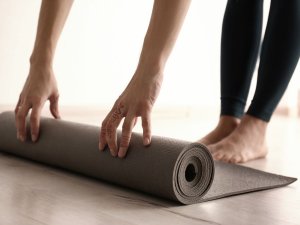News Post
Why Yoga Is a Perfect Practice for Practicing Lawyers
Published on January 29, 2020
By: Calle Mendenhall, Farris, Riley & Pitt
For most of us, finding an hour or two in our day to squeeze in any form of physical activity, let alone finding time to separate ourselves from our phones, is a victory. We’re often in between client calls, e-mails with opposing counsel and preparing for that merger or trial we have looming over us in the coming weeks. But what if there was a class you could go to just for an hour where you had to leave your phone outside, get a good workout and incorporate meditation?
 The answer is yoga. Although nearly all of us have heard about yoga and its benefits, a lot of us don’t know how easy it is to incorporate into your daily routine. For those who have never gone, images of hippies chanting or doing some contortionist acrobatics is likely what comes to mind. But that is not the reality of what a yoga class involves. Yoga is something everyone can do, and everyone can benefit from.
The answer is yoga. Although nearly all of us have heard about yoga and its benefits, a lot of us don’t know how easy it is to incorporate into your daily routine. For those who have never gone, images of hippies chanting or doing some contortionist acrobatics is likely what comes to mind. But that is not the reality of what a yoga class involves. Yoga is something everyone can do, and everyone can benefit from.
Yoga is called a “practice” because it requires time and patience with yourself before you improve. Just like the practice of law builds one case or transaction at time, yoga builds one class at a time. According to the Merriam-Webster Dictionary, “practice”, in this setting, means “to perform or work at repeatedly so as to become proficient.” When we walked in to our first legal jobs, we barely knew how to apply the law we learned in law school. Over years of practice, we grow proficient and more adept about our practice area. The same is true of yoga. When you walk into your first class, it is natural to feel like you know nothing and that everyone will have you pegged as the newbie. In a practice, everyone starts somewhere.
So how does yoga benefit a practicing lawyer? Here are some of the top health statistics:
- Yoga improves posture and relieves your body from the aches and pains of #desklife. We are all too often hunched over our keyboards and cell phones to maintain a straight spine. Additionally, the chairs most of us use in our offices are not designed to protect your back and neck. Yoga improves core strength and increases your flexibility and range of motion to help you loosen up those tight muscles at the end of the day.
- Yoga Reduces Stress. Studies have shown regular yoga practice can decrease secretion of cortisol. In a recent study, yoga was specifically shown to decrease the levels of cortisol in alcohol dependent individuals. Additionally, a study of 131 people showed that after 10 weeks, yoga can reduce stress and anxiety. Study participants notes an improvement in the quality of life and mental health
- Yoga Reduces Anxiety. In a study of 64 women with PTSD (a form of severe anxiety), women were instructed to practice yoga once a week for 10 weeks. At the conclusion of the study, the women had fewer symptoms and 52% no longer met the criteria for PTSD.
- Yoga Improves Heart Health. Participants in a study over 40 years old who practiced yoga for five years had lower blood pressure and pulse rate than those who didn’t. The study concluded that yoga reduces the age-related deterioration in cardiovascular functions.
- Yoga Helps with Depression. Although more studies are needed. One small study of 28 volunteers, ages 18-29 who were experiencing mild levels of depression and had no prior experience with yoga were instructed to attend two 1-hour yoga classes each week for 5 consecutive weeks. At the end of the 5 weeks, the volunteers self-reported significant decreases in depression symptoms and trait anxiety.
Arthur Fama, a former practicing attorney and now the assistant dean for student affairs at the NYU School of Law, has practiced yoga for over 15 years and now runs a yoga class every Monday at NYU. Fama notes that yoga also helps lawyers in the following ways:
- Allows us to listen mindfully-to listen to the answer instead of racing ahead, ie-staying in the moment.
- Creates a balance between the right and left sides of our brains-allows us to engage our analyses of issues with a more creative openness.
- Allows for us to make space between seeing the problem and tackling it
- Help us filter out thoughts that we don’t need.
For those times that you simply can’t make it to an actual class, there are a plethora of articles on easy ways to incorporate yoga into your daily routine for the time you do have. The next time you are on a long conference call or reached your limit drafting a brief, pull up one of these articles and run down the list for a quick break that your shoulders, neck, and back will be ecstatic about.
- https://www.doyouyoga.com/7-yoga-poses-you-can-do-at-your-work-desk-to-relieve-stress-68712/
- https://www.huffpost.com/entry/office-yoga-poses_b_5604195
- http://www.wealthywebwriter.com/wp-content/uploads/2011/01/Yoga_poses_at_desk.jpg
- http://darebee.com/images/workouts/office-yoga-workout-intro.jpg